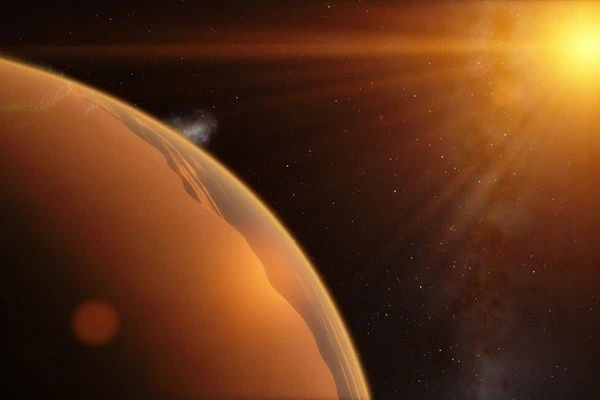An international team of researchers from the Universities of Bern and Geneva, as well as the National Centre of Competence in Research (NCCR) PlanetS, examined the atmosphere of one of the most extreme known planets in great detail. The findings from this hot, Jupiter-like planet, which was discovered using the CHEOPS space telescope, may help astronomers understand the complexities of many other exoplanets, including Earth-like planets.
The Earth’s atmosphere is not a uniform envelope, but rather a series of distinct layers, each with its own set of properties. The troposphere, which extends from sea level to the highest mountain peaks, contains the majority of the water vapour and thus is the layer in which most weather phenomena occur. The layer above it, the stratosphere, contains the famous ozone layer, which protects us from the Sun’s harmful ultraviolet radiation.
In a new study that appeared in the journal Nature Astronomy, an international team of researchers led by the University of Lund show for the first time that the atmosphere of one of the most extreme known planets may have similarly distinct layers as well — albeit with very different characteristics.
We measured the light coming from the planet’s host star and passing through the planet’s atmosphere. The gases in its atmosphere absorb some of the starlight, similar to Ozone absorbing some of the sunlight in Earth’s atmosphere, and thereby leave their characteristic ‘fingerprint’.
Bibiana Prinoth
An exotic cocktail for an atmosphere
WASP-189b is a planet 322 light years from Earth that exists outside of our solar system. Extensive observations with the CHEOPS space telescope in 2020 revealed that the planet is 20 times closer to its host star than Earth is to the Sun, and that it has a daytime temperature of 3200 degrees Celsius. Recent studies with the HARPS spectrograph at Chile’s La Silla Observatory have now allowed researchers to take a closer look at the atmosphere of this Jupiter-like planet for the first time.
“We measured the light coming from the planet’s host star and passing through the planet’s atmosphere. The gases in its atmosphere absorb some of the starlight, similar to Ozone absorbing some of the sunlight in Earth’s atmosphere, and thereby leave their characteristic ‘fingerprint’. With the help of HARPS, we were able to identify the corresponding substances,” lead author of the study and doctoral student at Lund University, Bibiana Prinoth, explains. According to the researchers, the gases that left their fingerprints in the atmosphere of WASP-189b included iron, chromium, vanadium, magnesium and manganese.

An “Ozone layer” on a blisteringly hot planet?
One particularly intriguing substance discovered by the team is titanium oxide, a gas containing titanium. While titanium oxide is extremely rare on Earth, it may play an important role in the atmosphere of WASP-189b, similar to ozone in our atmosphere. “Short-wave radiation, such as ultraviolet radiation, is absorbed by titanium oxide. Its detection could thus point to a layer in WASP-189b’s atmosphere that interacts with stellar irradiation in the same way that the Ozone layer does on Earth “Kevin Heng, a professor of astrophysics at the University of Bern and a member of the NCCR PlanetS, explains the study’s co-author.
The researchers discovered hints of such a layer as well as other layers on the ultra-hot Jupiter-like planet. “Our analysis revealed that the ‘fingerprints’ of the various gases differed slightly from what we expected. We believe that strong winds and other processes are to blame for these changes. And because different gases’ fingerprints were altered in different ways, we believe this indicates that they exist in different layers, similar to how the fingerprints of water vapour and ozone on Earth would appear differently altered from a distance because they mostly occur in different atmospheric layers “Prinoth elaborates. These findings could alter how astronomers investigate exoplanets.
A different way to look at exoplanets
“In the past, astronomers frequently assumed that exoplanet atmospheres exist as a uniform layer and attempted to understand them as such. However, our findings show that the atmospheres of even the most intensely irradiated giant gas planets have complex three-dimensional structures “Jens Hoeijmakers, study co-author and associate senior lecturer at Lund University, emphasizes this.
“We are convinced that understanding these and other types of planets, including those more similar to Earth, requires understanding the three-dimensional nature of their atmospheres. This necessitates advances in data analysis techniques, computer modeling, and basic atmospheric theory” Kevin Heng wraps things up.














